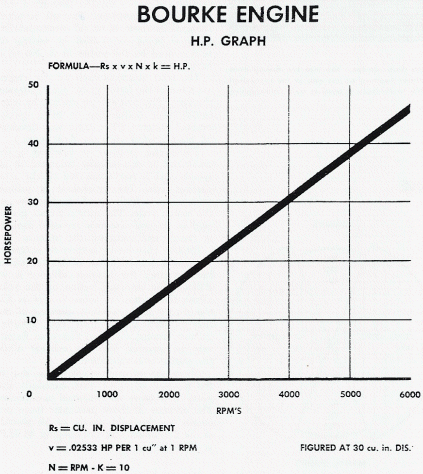|
Russell's Bourke 30 Explained In Simple Terms Care of Hot Rod Magazine, 1954. Excerpted from the authentic original Bourke Engine Documentary, pages 111 thru 114, sold by Bourke-Engine.Com
Original author of this article, George Hill, calls the Bourke engine a 2-stroke. It is not a 2-stroke engine. It is a 1 stroke engine taking care of all 4 cycles in one stroke 2 times per revolution! Edited and reformatted for clarity and content by David Wolfe, Founder, Bourke-Engine.Com. Free to copy, share and distribute as long as you refer to www.Bourke-Engine.Com as the originator and give credit to Russell Bourke and the editor. Also, check out www.projectbourke.com for lots of current pictures and video clips on this remarkable little powerhouse! Updated regularly! | ||
| 3 |
| |
|
COMBUSTION / OXIDATION PROCESS
Low grade fuel has proven to be the most satisfactory in the Bourke engine. Its low burning characteristics build a cushion and its high heat potential is released at high compression, while the piston dwells at top dead center and all of the air / fuel mixture is consumed (oxidized).
Since all heat is extracted at the top of piston travel, temperatures over 2000 degrees F and pressure over 1000 psi are generated, the flame dies out completely, and the rapid expansion of the gases on the inward stroke cool themselves and create, in fact, a refrigeration cycle. Paper matches held in the exhaust port will not light and the gases at the port feel only warm to the touch when all adjustments are correct. Best results to date have been achieved with a mixture of three parts white gas (Coleman stove oil) to one part brown gas (1-K Kerosene) but can be varied to suit local fuels, altitude, etc.
From the foregoing, it is obvious that this cannot be thought of wholly as a conventional reciprocating engine. The power curve is similar to that of a turbine engine. (See graph below) It has, however, the advantage of extreme economy which is not possible with a turbine engine. Engine speeds approaching those of turbines will be possible when a faster firing ignition system can be devised.
|
In summing up the operation of this all new engine, we discover quite a number of outstanding features:
1 - A reduction of moving parts to complete 4 cycles.
2 - No dead strokes to absorb power.
3 - Reduction of weight, complexity and parasitic losses due to lack of flywheel, camshaft, cam gears, poppet valves, etc.
4 - A far greater power output for any given displacement as the engine can be operated at much higher rpm's without appreciable power fall-off. Naturally valve float is non-existent in an engine that has no poppet valves.
5 - There is absence of both shearing stresses and cylinder wear as the pistons operate in a straight line and never come into contact with the cylinder walls. Rings serving as a compression seal only, are made of low tension material and create only a minimum of friction and wear on the cylinder walls.
6 - The engine has no mechanical sounds, can be operated in any position desired, can be run clockwise or counter-clockwise at will, all parts are interchangeable, and there is no need of specialized tools or machinery to manufacture it.
7 - It operates on very low octane fuel with practically no exhaust fumes, no flame and very little waste heat.
These facts are all very interesting but the thing that will be of primary interest to hot rodders and piston heads everywhere is the fact that these 30 cubic inch, two cylinder opposed engines can be bolted together in clusters to achieve an engine of almost any displacement desired! The total weight of each 30 cubic inch engine is only 38 pounds.
The next question on every ones lips is, "how many horses will it deliver?" The final answer to this question is an unknown factor. The horsepower is limited only by the number of cylinders and rpm's the engine can turn. So, use your imagination and of course the information contained in this article. Do the math. It's quite impressive in any case and far superior to any conventional 2 or 4 stroke or Wankel engine. Bourke's own specially built battery ignition system will turn up to 15,000 rpm, or an estimated 114 brake horsepower. Experiments have been made using glow plugs and with them the engine is reported to have turned well in excess of 20,000 rpm!
Glow plugs, however, will hardly be acceptable in closed competition for the engine cannot be shut off immediately. There are possibilities of adapting an efficient fuel valve, built into the engine near the injector nozzles, that could shut the engine down in short time. Perhaps a compression release, similar to diesel installations would work even better.
Continued on page 52 of the July issue of Hot Rod Magazine 1954. minus the changes made by the editor of this article.
*******************************************************
An electronic copy of the original and authentic Bourke Engine Documentary, by Lois Bourke can be obtained here. Contains tons more information, pictures, theories and basis for Russell Bourke's designs and discoveries regarding his remarkable engine!
Return to the home page of www.projectbourke.com
| |
